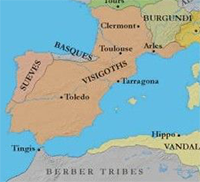Pre-Roman Spain
Rome controlled what is now Spain for centuries, gaining a foothold during the preeminence of Carthage, then conquering the entire peninsula, then losing it first to various Germanic tribes and then to Moorish armies. 
The Romans, after defeating Carthage in the Punic Wars, had initially divided the peninsula into two provinces, Hispania Citerior (Near) and Hispania Ulterior (Far). In the west later was Lusitania (with its capital at Mérida), which many years later became Portugal. That area held off Roman occupation for many years, as did the city of Numantia. As with many other area civilizations, however, Rome was eventually the master of the Iberian Peninsula. By 19 B.C., Baetica and Tarraconensis were provinces of Hispania as well. The by-products of Roman civilization spread throughout Spain. Roads connected cities, other aspects of Roman civilization (like aqueducts and baths and villas and fora) grew in number, and trade between Spain and the rest of the Roman world proliferated. Rome granted citizenship to native peoples, as had been done elsewhere in the Republic and then the Empire. Some of Rome's most famous names came from Hispania: Lucan, Marcus Aurelius, Seneca, and Trajan. 
Germanic tribes spilled over into Hispania in the 5th Century, after the Empire had split in two. The Alans and Vandals preceded the Visigoths in occupying some and then much of the peninsula. Settling in Lusitania were the Suevi. The Visigoths, after ousting the other Germanic tribes, ruled for a time, with a capital at Toledo. They then fought a fierce battle with Belisarius and troops from the Byzantine Empire. The invaders triumphed and ruled for a time, with a capital at Cordoba. The Visigoths regained control in 616. They held it for close to a century, until the powerful Moors arrived.
|
|
Social Studies for Kids
copyright 2002–2025
David White




